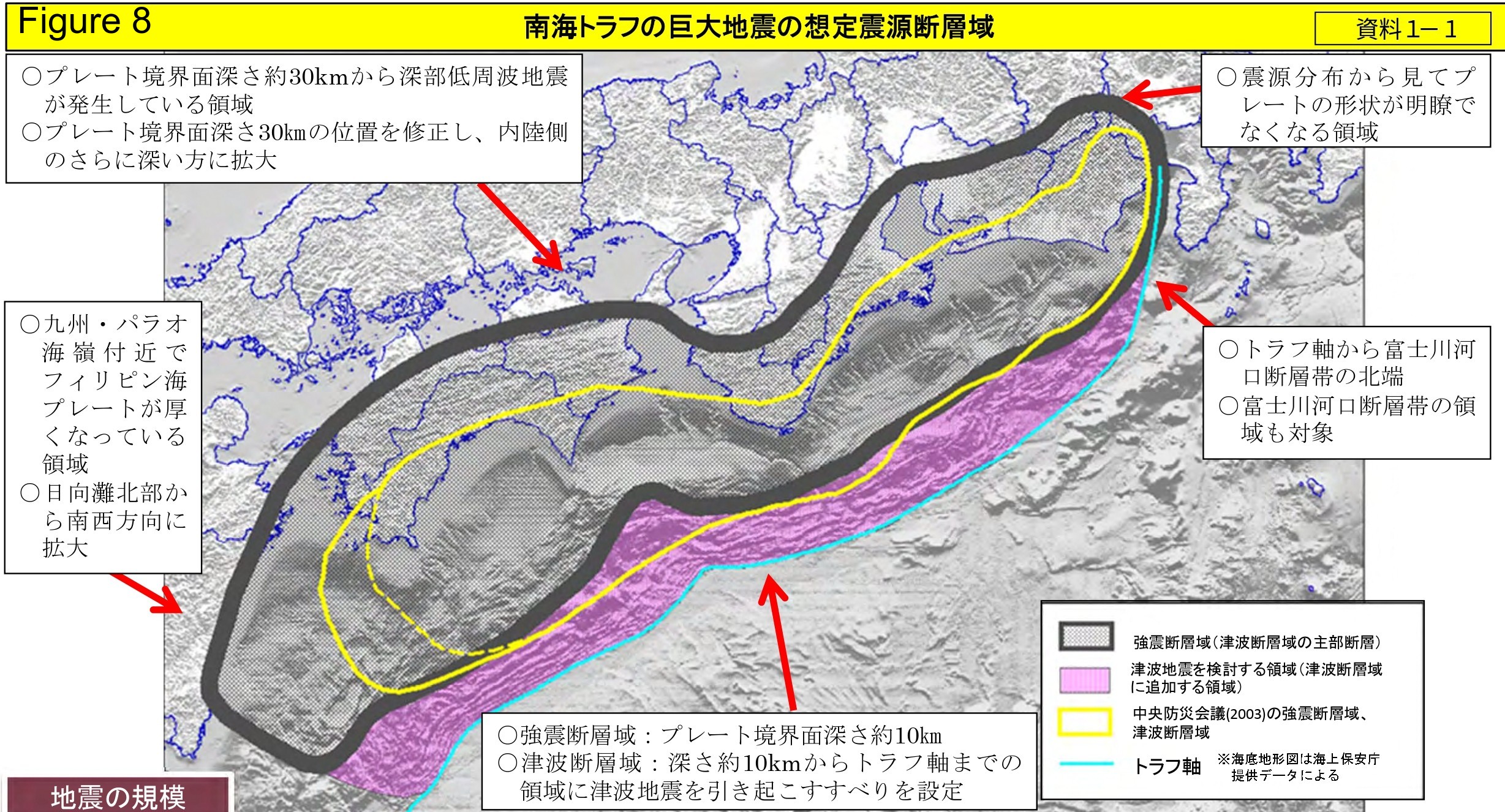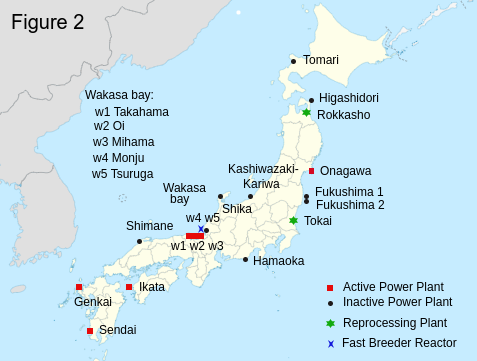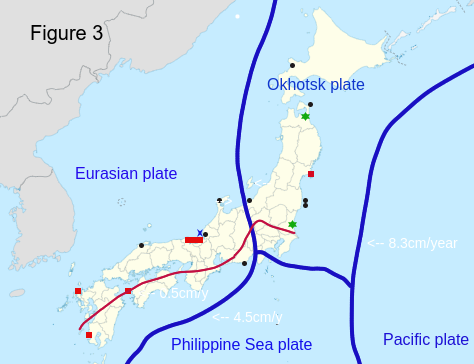Earthquakes and Nuclear Facilities
1. Overview
In the 2011 Tohoku earthquake, 22,000 people were killed by the tsunami and three nuclear reactors melted down. According to TEPCO (Tokyo Electric Power Company), they have been pouring 400 tons of water over the melted fuel everyday and the contaminated water has been flowing into the Pacific ocean since 2011. It is an extremely serious contamination. However, thanks to the dedicated efforts of many people we were successful in avoiding the catastrophic ends such as the explosion of the nuclear reactors and the melt down of the spent nuclear fuel in the cooling pool.
We are now facing another big earthquake in the south pacific coast. It is the geographic nature of Japan. Throughout history we experienced big earthquakes of M8.4 class in the interval of about 100 to 150 years. According to the new damage estimation (NHK [8]), 298,000 people are going to be killed by the earthquake. However, in Ikata the No 3 reactor is still running using the MOX fuel and 770 tons of the spent fuel is stored in the cooling pool. In Hamaoka, 1,130 tons of the spent fuel is stored in the cooling pool. This contradiction is imposing on us the unprecedented danger in the history of human beings. The fortune in Fukushima will not happen again.
2. Earthquakes Japan is on the top of the boundaries of four tectonic plates.(Figure 1) Pacific plate subducts beneath Okhotsk plate and Philippine Sea plate at the rate of 8.3 cm per year. Philippine Sea plate subducts beneath Eurasian plate at the rate of 4.5 cm per year.(SAGE [1]) The complicated force caused by the slow compression between Eurasian plate and Okhotsk plate and the subduction between Philippine Sea plate and Eurasian plate resulted in numerous fault lines which are active or inactive, known or hidden. The Median Tectonic Line is one of the biggest fault lines in the world and the south side of the fault line moves toward west at the rate of 0.5 cm per year. (SAGE [1], GSI [2], JMTL [3]) The subduction of plates accumulates the elastic energy each year and releases it abruptly in a few minutes.
Japan is on the top of the boundaries of four tectonic plates.(Figure 1) Pacific plate subducts beneath Okhotsk plate and Philippine Sea plate at the rate of 8.3 cm per year. Philippine Sea plate subducts beneath Eurasian plate at the rate of 4.5 cm per year.(SAGE [1]) The complicated force caused by the slow compression between Eurasian plate and Okhotsk plate and the subduction between Philippine Sea plate and Eurasian plate resulted in numerous fault lines which are active or inactive, known or hidden. The Median Tectonic Line is one of the biggest fault lines in the world and the south side of the fault line moves toward west at the rate of 0.5 cm per year. (SAGE [1], GSI [2], JMTL [3]) The subduction of plates accumulates the elastic energy each year and releases it abruptly in a few minutes.
The Tohoku earthquake in 2011 occurred in the boundary of the Okhotsk plate and the Pacific plate. Over 22,000 people were killed by the tsunami and three nuclear reactors in Fukushima melted down. Now we are facing large-scale earthquakes in the boundary of the Philippine Sea plate and the Eurasian plate. The earthquakes of M8.4 have occurred along the south pacific coast of Japan periodically in about 150-years intervals. They are called the Nankai Trough Earthquake, but they are twin earthquakes which consist of Tokai (south-east pacific coast) earthquake and Nankai (south-west pacific coast) earthquake and have occurred together in history. (Table 1)
Table 1: Tokai and and Nankai earthquakes in history
Kouwa Tokai earthquake (M8.5) 1096 A.D.
Kouwa Nankai earthquake (M8.3) 1099 A.D.
Shouhei Tokai earthquake (M8.4) 1360 A.D.
Shouhei Nankai earthquake (M8.4) 1361 A.D.
Meiou Tokai earthquake (M8.4) 1498 A.D.
Meiou Nankai earthquake (M8.4) 1498 A.D.
Keichou Tokai earthquake (M8.0) 1605 A.D.
Keichou Nankai earthquake (M7.9) 1605 A.D.
Houei Tokai earthquake (M8.4) 1707 A.D.
Houei Nankai earthquake (M8.4) 1707 A.D.
Ansei Tokai earthquake (M8.4) 1854 A.D.
Ansei Nankai earthquake (M8.4) 1854 A.D.
Tokai-Nankai earthquake (M7.9) 1944 A.D.
Shouwa Nankai earthquake (M8.0) 1946 A.D.
The last one of M8.4 class, Ansei Tokai and Ansei Nankai earthquakes, occurred in 1854. According to the video made by the Japanese government the next Nankai Trough Earthquake (Tokai and Nankai earthquakes) will occur soon and 298,000 people are going to be killed by the earthquake.(Cabinet Office [4], NHK [8]) The video concludes with the remark that although we can not avoid the earthquakes we can prepare many things to minimise the damage. However, several nuclear power plants have been built and are still running in the areas supposed to suffer the most serious damage. Hamaoka nuclear power plant is built on the top of the plate boundary among three plates (Philippine sea plate, Okhotsk plate and Eurasian plate). The Ikata nuclear power plant is built on the top of the Median Tectonic Line. The Sendai nuclear power plant is in the middle of the active volcanic zone.
When an earthquake occurs, the area where the fault plane breaks and shifts is called the seismic source zone. Especially, near the plate boundaries the area which moves at high speed during an earthquake, generating seismic waves, is called the strong earthquake fault zone. In the Nankai Trough Earthquake the strong earthquake fault zone is shown by the circle of grey bold line in Figure 8. (Cabinet office [9]) It includes the large area of the south side of the Median Tectonic Line. In the Tohoku earthquake in 2011, the seismic source zone was 160 km away from the coast, but in the Nankai Trough Earthquake it might be directly underneath the nuclear power plants.
3. Nuclear power plants
 There are 16 major power plants, two reprocessing plants (Rokkasho, Tokai), and one fast breeder reactor (Monju) in Japan. (Figure 2)(Nuclear power of Japan [5]) As of January in 2025, 13 reactors in the 7 power plants are operating, Onagawa (unit 2), Genkai(unit 3, unit 4), Ikata(unit 3), Sendai(unit 1, unit 2), Takahama(unit 1, unit 2, unit 3, unit 4), Oi(unit 3, unit 4), Mihama(unit 3).
There are 16 major power plants, two reprocessing plants (Rokkasho, Tokai), and one fast breeder reactor (Monju) in Japan. (Figure 2)(Nuclear power of Japan [5]) As of January in 2025, 13 reactors in the 7 power plants are operating, Onagawa (unit 2), Genkai(unit 3, unit 4), Ikata(unit 3), Sendai(unit 1, unit 2), Takahama(unit 1, unit 2, unit 3, unit 4), Oi(unit 3, unit 4), Mihama(unit 3).
Each nuclear reactor produces about 100 tons of spent nuclear fuel each year. The radioactivity of the spent nuclear fuel is billion-times more intense than the natural uranium. About 19,000 tons of spent nuclear fuel are stored in Japan. For instance, 1,130 tons of spent nuclear fuel is stored in the cooling pool in Hamaoka and 770 tons and 1,140 tons are kept in Ikata and in Sendai respectively. The cooling pools exist in the same space where we live our daily lives and the loss of electricity causes the meltdown of the nuclear fuel within three days.
The earthquake‐resistant limits of the nuclear power plants are about M6.5 (620 Gal – 1200 Gal), since the nuclear power plants in Japan are just copies of the ones in USA where the earthquake is not a major risk factor. The anticipated earthquake of M8.4 has 700 times more energy than that of M6.5. There were many earthquakes with much larger gal, such as 4022 gal in Iwate-Miyagi inland earthquake in 2008, 2933 gal in the Tohoku earthquake in 2011 and 2828 gal in the Noto earthquake in 2024. In the Nankai Trough Earthquake the seismic source might be directly underneath the nuclear power plants and they would suffer extremely fierce quake.
In reprocessing plants, the spent nuclear fuel is melted in the high temperature to retrieve uranium and plutonium. The remaining substance is called high-level radioactive waste. Vitrified waste is obtained by melting the high-level radioactive waste with glass and solidifying it in the steel vessel. JAEA (Japan Atomic Energy Agency) keeps 6,500 high-level radioactive solid waste (in the 200-liter vessel), 404 cubic meters of high-level radioactive liquid waste and 247 vitrified waste (in the 120-liter vessel) in Tokai. JNFL (Japan Nuclear Fuel Limited) has 1367 vitrified waste (in the 150-liter vessel) in Rokkasho.(JAEA [6]) Most of vitrified waste (1310 vitrified waste) were made in France. JAEA had planned to vitrify the high-level radioactive liquid waste until 2028, but after the series of accidents they postponed the schedule until 2038.
Fast breeder reactor uses plutonium 239 instead of uranium 235 as the fuel and generates more plutonium 239 at the end of the process. The reactor uses the liquid sodium as the coolant and it is extremely difficult to safely operate with this explosive substance. In 2016, the Japanese government confirmed the closure of the fast breeder reactor Monju. Monju has never run. Fortunately the reactor, the fuel and the sodium have not been radioactively contaminated. The decommission process of Monju is a much easier task compared to that of RAPSODIE and SUPERPHÉNIX, but in the plan of JAEA it is going to take 30 years until 2047. (IAEA [7]) Plutonium is an extremely harmful substance for living creatures. 500 gram of plutonium can kill two billion people. There are about 8.6 tons of plutonium stored in Japan (400 kg in Monju), which must be kept safely isolated from the biosphere.
 Figure 3 is the combination of Figure 1 and Figure 2. In Ikata nuclear power plant located on the top of the Median Tectonic Line, the No 3 reactor is still running using the MOX fuel and 770 tons of the spent fuel is stored in the cooling pool. In Hamaoka nuclear power plant built on the top of the three tectonic plates boundaries, 1,130 tons of the spent fuel is stored in the cooling pool. From the experience of Fukushima 2011 we know that no one can save the nuclear disaster. No one even knows what would happen if the spent nuclear fuel melted down in the cooling pools. No research has not been conducted based on such a condition. However, the radioactive cloud is going to be generated continuously and cover the whole globe. All of us are going to lose safe food and safe water forever.
Figure 3 is the combination of Figure 1 and Figure 2. In Ikata nuclear power plant located on the top of the Median Tectonic Line, the No 3 reactor is still running using the MOX fuel and 770 tons of the spent fuel is stored in the cooling pool. In Hamaoka nuclear power plant built on the top of the three tectonic plates boundaries, 1,130 tons of the spent fuel is stored in the cooling pool. From the experience of Fukushima 2011 we know that no one can save the nuclear disaster. No one even knows what would happen if the spent nuclear fuel melted down in the cooling pools. No research has not been conducted based on such a condition. However, the radioactive cloud is going to be generated continuously and cover the whole globe. All of us are going to lose safe food and safe water forever.
References
[1] SAGE, Japan’s Earthquakes and Tectonic Setting, https://www.iris.edu/hq/inclass/animation/japans_earthquakes__tectonic_setting
[2] Geospatial Information Authority of Japan (GSI), The Niigata-Kobe Tectonic Zone, https://www.gsi.go.jp/cais/tectonics_niigata_kobe-e.html#:~:text=The%20Japanese%20Islands%20belongs%20to,Sea%20plates%20(Figure%201).
[3] Wikipedia (JMTL), Japan Median Tectonic Line, https://en.wikipedia.org/wiki/Japan_Median_Tectonic_Line
[4] Cabinet Office Government of Japan, Nankai Trough Earthquake, https://wwwc.cao.go.jp/lib_012/nankai_all_en.html
[5] Wikipedia, Nuclear power of Japan, https://en.wikipedia.org/wiki/Nuclear_power_in_Japan#cite_note-99
[6] JAEA, Nuclear Wastes in Japan, https://atomica.jaea.go.jp/data/detail/dat_detail_05-01-01-05.html
[7] IAEA, Operational and decommissioning experience with fast reactors, https://www.iaea.org/publications/6927/operational-and-decommissioning-experience-with-fast-reactors
[8] NHK, Damage estimation of Nankai Trough Earthquake, https://www3.nhk.or.jp/news/html/20250331/k10014762791000.html#anchor-20
[9] Cabinet office, Seismic source zone of Nankai Trough Earthquake, https://www.bousai.go.jp/jishin/nankai/taisaku/pdf/1_1.pdf